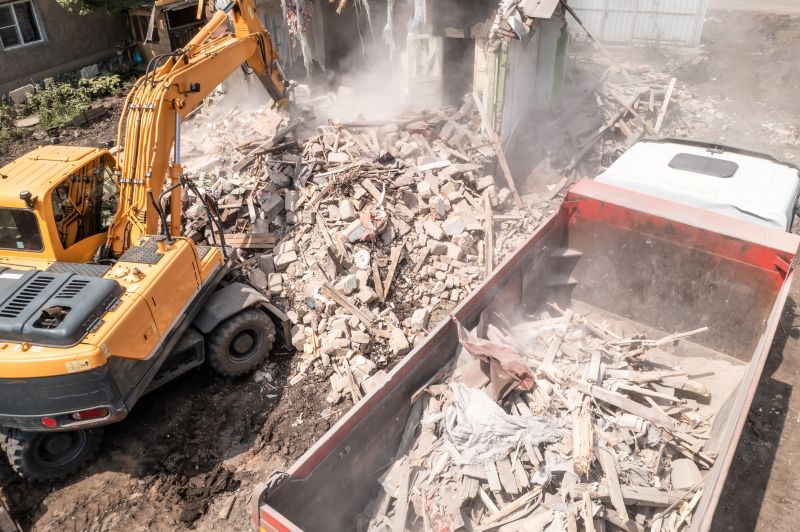Expert Picks for Demolition and Hauling Service Equipment You Can Trust
Find high-performance tools and machinery selected by industry experts to ensure smooth and safe project execution.
 When undertaking demolition and hauling projects, selecting the right tools and equipment is essential for efficiency and safety. This category encompasses a wide range of products designed to facilitate the safe removal of structures, debris, and materials. From heavy-duty machinery to hand tools, the right gear can make a significant difference in completing projects smoothly. Whether working on residential renovations, commercial demolitions, or large-scale construction cleanups, having reliable equipment is crucial.
When undertaking demolition and hauling projects, selecting the right tools and equipment is essential for efficiency and safety. This category encompasses a wide range of products designed to facilitate the safe removal of structures, debris, and materials. From heavy-duty machinery to hand tools, the right gear can make a significant difference in completing projects smoothly. Whether working on residential renovations, commercial demolitions, or large-scale construction cleanups, having reliable equipment is crucial.
Types of Products For Demolition And Hauling Service
Hydraulic Excavators
Powerful machines used for digging, demolition, and lifting heavy materials, suitable for large-scale projects.
Skid Steer Loaders
Compact and versatile loaders capable of handling debris, grading, and excavation tasks in tight spaces.
Jackhammers and Demolition Saws
Handheld tools designed for breaking concrete, asphalt, and other tough materials with precision.
Dump Trailers
Portable trailers used to transport debris and materials from the demolition site to disposal areas.
Wheelbarrows and Material Carts
Manual tools for moving smaller quantities of debris efficiently across the site.
Pry Bars and Crowbars
Hand tools essential for prying apart structures and removing stubborn debris.
Concrete Crushers
Machines designed to break down concrete structures into manageable pieces for removal.
Dust Suppression Systems
Equipment that helps control dust during demolition activities for improved safety and cleanup.
Safety Helmets and Protective Gear
Essential protective equipment to ensure safety during demolition and hauling operations.
Lifting Straps and Slings
Tools used for securing and lifting heavy materials safely during demolition.
Debris Containment Bins
Secure bins for collecting and containing debris on-site, simplifying cleanup.
Forklifts
Heavy machinery used for lifting and moving large loads of debris or materials around the site.
Portable Generators
Power sources for tools and equipment in remote or outdoor demolition sites.
Ripping and Demolition Attachments
Specialized attachments for excavators to enhance demolition capabilities.
Vibratory Plate Compactors
Equipment used to compact soil and debris after removal, ensuring a stable ground surface.
Popular Choices
Compact excavators suitable for small to medium demolition tasks, offering maneuverability and power.
Cordless or electric-powered tools designed for lighter demolition work with reduced noise levels.
Large-capacity trailers for efficient debris hauling, compatible with various vehicles.
Powerful tools ideal for breaking concrete and masonry with minimal effort.
Access equipment for reaching high or difficult areas safely during demolition.
Devices that help control airborne dust, improving site visibility and safety.
Attachments for excavators that deliver high-impact force for breaking tough materials.
Protective gloves designed for handling rough materials and operating heavy machinery.
Large containers placed on-site for organized debris collection and disposal.
Lighting solutions for illuminating work areas during evening or indoor demolition.
Versatile attachments like grapples and buckets for various demolition and hauling tasks.
Equipment used to pull or lift heavy debris or materials across the site.
Tools for mixing concrete on-site during demolition or rebuilding phases.
Equipment for lifting and positioning large materials or debris safely.
Devices designed to minimize noise during demolition activities for compliance and safety.
Demolition and hauling often involve dealing with heavy, bulky materials that require specialized equipment to manage effectively. Heavy machinery such as excavators, bulldozers, and skid steers are commonly used for breaking down structures and moving large quantities of debris. For smaller or more precise tasks, hand tools like sledgehammers, pry bars, and demolition saws are valuable. Additionally, transport equipment such as wheelbarrows, dollies, and cargo trailers help in efficiently moving debris from the site to disposal areas.
Safety is a primary concern in demolition and hauling operations. Proper protective gear including gloves, helmets, eye protection, and durable footwear is essential. Equipment that enhances safety, such as dust suppression systems and secure containment bins, can help mitigate hazards. Moreover, considering the compatibility of tools with the scope of the project ensures that tasks are performed efficiently without unnecessary delays. Proper planning and equipment selection are key to maintaining productivity and safety throughout the project lifecycle.
Key Buying Considerations
- Assess the scale and scope of your demolition or hauling project to determine the appropriate equipment size and capacity.
- Consider the power source of tools and machinery, such as electric, pneumatic, or fuel-powered options, based on site accessibility.
- Ensure compatibility of attachments and accessories with your existing equipment for versatility and efficiency.
- Prioritize safety features and protective gear to maintain a safe working environment.
- Evaluate the maneuverability and size of equipment for working in confined or complex spaces.
- Check the availability of spare parts and service support for long-term maintenance.
- Review the weight and transportation requirements of machinery to ensure compliance with site and vehicle limitations.
- Opt for equipment with adjustable settings to adapt to different materials and demolition tasks.
- Consider noise levels and vibration output, especially in urban or noise-sensitive environments.
- Determine the ease of operation and user-friendliness of tools for operators with varying experience levels.
- Factor in the disposal and containment features of debris handling products to streamline cleanup.
- Review the durability and build quality to withstand demanding demolition conditions.
- Assess the overall budget and potential return on investment for more advanced or multifunctional equipment.
- Look for equipment that offers safety certifications and compliance with industry standards.
- Plan for future project needs by selecting adaptable and scalable tools and machinery.
This content contains affiliate links. We may earn a commission if you purchase through these links, at no additional cost to you.
